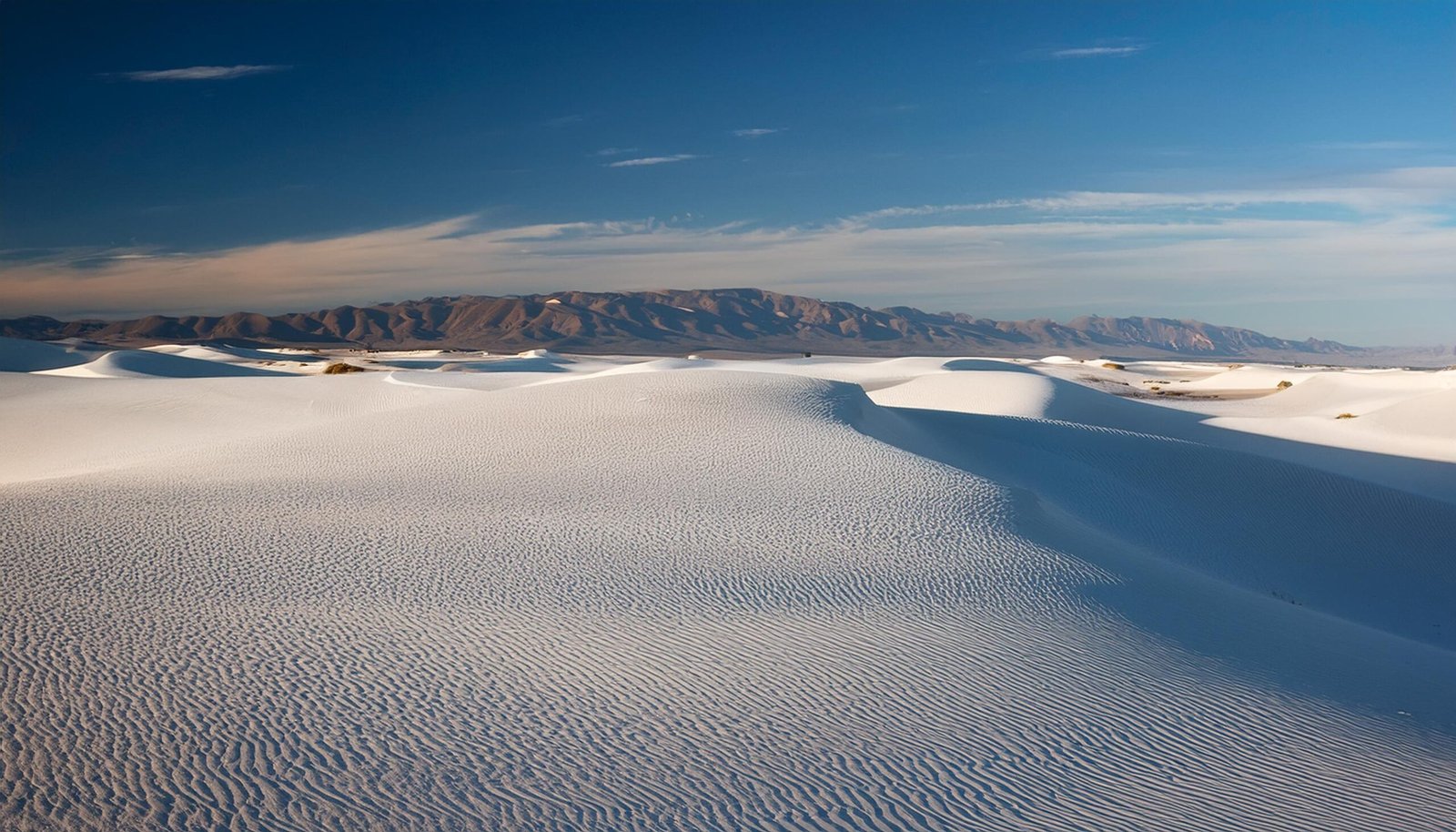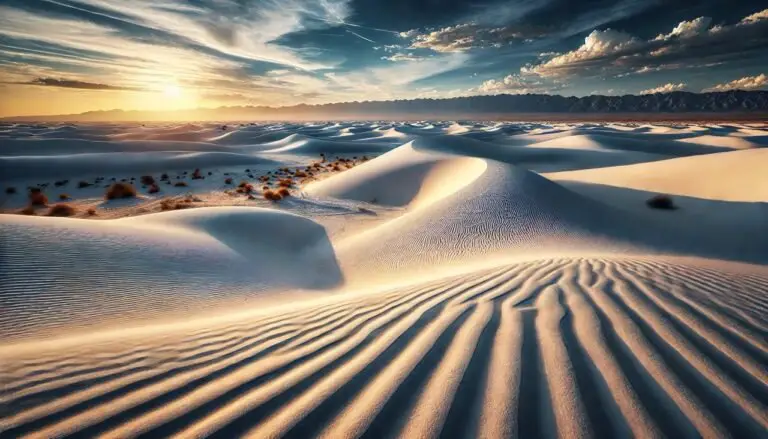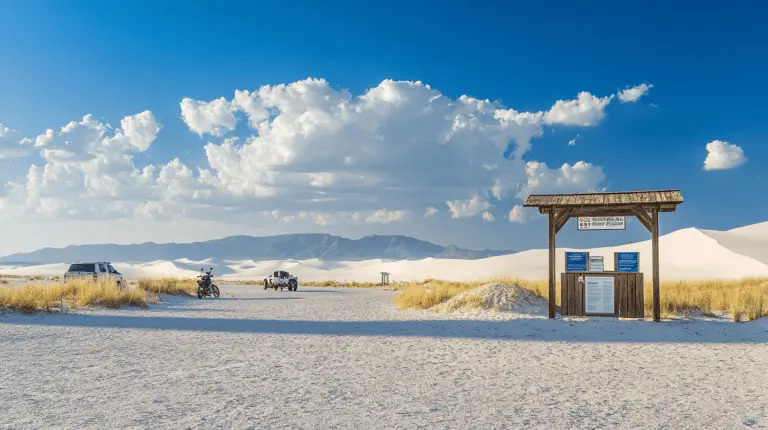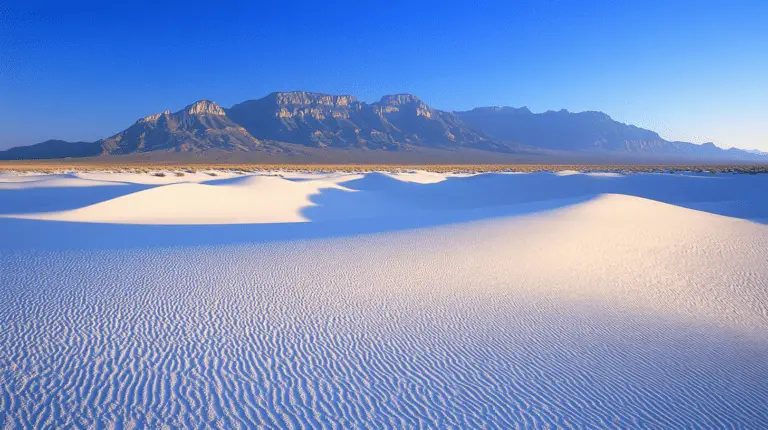Uncovering the Magic of White Sands National Park Gypsum
The Birth of the Dunes
When you stroll through White Sands National Park, you’re treading on the world’s largest gypsum dunefield. Picture this: around 280 million years ago, a sea called the Permian Sea covered this area. As the sea retreated, it left behind layers of gypsum on the ocean floor. Fast forward to today, and erosion plus renewal have shaped these incredible dunes.
A climate shift hit around 10,000 years ago, turning this place into the Chihuahuan Desert. Most of Lake Otero vanished, leaving behind Alkali Flat and the smaller Lake Lucero. Strong 17 mph winds started breaking down selenite crystals into the tiny, white grains of sand we see now. Curious for more details? Check out our geology page on White Sands National Park.
Gypsum Dunefield Snapshots
| Aspect | Info |
|---|---|
| Biggest Dunefield | 275 square miles |
| Wind Speed That Shapes It | 17 mph |
| Age of Formation | 280 million years |
The Quirky Ecosystem of White Sands
The ecosystem here is as rare as the sparkling white dunes themselves. Despite the desert’s tough vibes, both plants and animals have found ways to thrive. The massive gypsum dunes are always on the go, moving several feet in just one breezy day or night.
From frogs to the lone salamander, and an array of reptiles like snakes, lizards, and turtles, the park’s critters are a lively bunch. Dive deeper into the wildlife on our animals page for White Sands National Park.
Wildlife Variety
| Group | Examples |
|---|---|
| Amphibians | Frogs, Salamander |
| Reptiles | Snakes, Lizards, Turtles |
Experience the breathtaking landscape and unique ecosystem at White Sands National Park. Looking for more? Check out the park’s history or plan a trek with our hiking trails guide.
Wildlife Wonders at White Sands
White Sands National Park is teeming with life, offering a peek into nature’s secrets within its magical gypsum dunes. Today, let’s delve into two standout wildlife spectacles: the vibrant bird life and the one-of-a-kind White Sands pupfish.
Feathered Friends of White Sands
With over 220 bird species calling the park home, White Sands is an absolute haven for bird enthusiasts. Some regulars you might spot include roadrunners, mockers, wrens, and several raptors. These birds have learned to thrive in the desert’s challenging environment, where resources are scant.
| Bird Types | Usual Hangouts |
|---|---|
| Roadrunner | Ground level, among shrubs |
| Mockingbird | Open desert, singing spots |
| Wren | Dense bushes, undergrowth |
| Raptors | High vantage points, skies |
The park’s varied habitats offer these birds cozy niches to settle in. For instance:
- Wrens love thick shrubs where they can hide and nest.
- Mockingbirds enjoy open spaces and perch high to sing their hearts out.
- Raptors like hawks and eagles dominate the open sky, scanning for prey from their lofty perches.
Bird watchers, grab your White Sands National Park map, and find the best spots to catch these winged wonders in action.
Meet the White Sands Pupfish
The White Sands pupfish is a true marvel of evolutionary grit. This little fish is the sole fish species unique to the Tularosa Basin, thriving only in White Sands National Park (NPS – White Sands National Park). Pupfish are masters of adaptation, surviving dramatic temperature shifts and high salinity levels in their habitat.
| Trait | Description |
|---|---|
| Habitat | Tularosa Basin |
| Temperature | Handles wide variations |
| Salinity | Thrives in salty water |
If you’re hoping to catch a glimpse of these remarkable fish, head to the park’s crystal-clear waters. These areas are prime pupfish territory, where you can witness their resilience firsthand.
For the eco-curious, the White Sands National Park Visitor Center offers insightful exhibits and guided tours. You can learn about the web of life within the park, their living spaces, and ongoing conservation projects.
Gaining insight into White Sands’ wildlife enriches your visit and deepens your appreciation for this natural marvel. Discover the intricate beauty of the park’s ecosystem by checking out articles on White Sands NP and White Sands National Park Photography.
White Sands promises a memorable mix of natural beauty and unique wildlife experiences. Dive in and let nature surprise you!
Scientific Research at White Sands Park
Research at White Sands Park helps us understand its unique mix of plants, animals, and those eye-popping gypsum dunes. Let’s dive into the cool studies on groundwater and dune formation that show us what really makes this place tick.
Groundwater Study
Since 2009, White Sands has been all about figuring out its water story. Teaming up with a bunch of other science folks, they’ve been digging into how groundwater keeps the dunes alive. Turns out, the water keeping those dunes standing tall is linked to the larger groundwater in the area.
| Year | Study Focus | Key Findings |
|---|---|---|
| 2009 | Groundwater Connection | Water keeps the dunes alive |
| Ongoing | Hydrology Mapping | Tied to regional groundwater |
| Recent | Water Source Analysis | How dunes keep going |
Curious about the park’s life forms? Check out our section on the unique plants and animals of White Sands.
Dune Formation Studies
Dr. Ryan Ewing from Texas A&M University is the brain behind research on how dunes form and move in White Sands (National Park Service). With tech like LiDAR and weather stations, he’s uncovered some awesome stuff like:
- How new dunes start up
- How different winds shape the dunes
- The speed at which these sand hills drift
| Aspect | Method | What We Learned |
|---|---|---|
| New Dune Formation | LiDAR | How they get started |
| Dune Shapes | Weather Stations | Wind makes them unique |
| Dune Migration | LiDAR | How fast they move |
Meanwhile, Dr. Kathy Benison from West Virginia University and her team are all about the park’s lake system. They’ve found that gypsum is actively forming there, feeding the dunes with new sediment (National Park Service).
Want more on the park? Swing by our pages on geology and human history for the full scoop.
The Geological Wonders of White Sands
White Sands National Park is like nature’s own storybook, etched in the sands of time. Imagine an epic saga of ancient seas, shifting mountains, and vast, shimmering lakes—all right here in southwestern United States. Ready to dig into this amazing tale?
Ancient Times
Way back, around 280 to 250 million years ago, during the Permian era, the area that is now White Sands was part of a vast sea. The rise and fall of these ancient waters left behind thick layers of gypsum and other minerals on the ocean floor. This is the bedrock of White Sands’ gypsum riches (NPS.gov).
Fast forward to about 30 million years ago. Tectonic chaos was the order of the day. Plates shifted and mountains cracked creating the San Andres Mountains on one side, and the Sacramento Mountains on the other. This energetic reshuffling also birthed the Tularosa Basin, now home to White Sands National Park (NPS.gov).
Jump ahead another 2 to 3 million years, and you find Lake Otero sprawling across 1,600-square miles of the Tularosa Basin. But about 12,000 years ago, this vast lake evaporated, leaving behind a dry lake bed known as a playa. This landscape is part of what you now explore when visiting White Sands.
Modern Marvels
But wait, the story doesn’t end there. White Sands is still a geological playground. Fault lines and tectonic nudges continue to tweak the landscape. Massive gypsum dunes, sprawling over 176,000 acres—yes, the largest gypsum dune field in the world—are in constant motion.
Roughly 10,000 years ago, a climate shift steered the region into what we see today—a slice of the Chihuahuan Desert pie. Lake Otero dried up—or you might say exited stage left—leaving behind Alkali Flat and Lake Lucero. Wind, willing to play its part, crumbled selenite crystals into the fine, white gypsum sand that now dazzles tourists (NPS.gov).
| Geological Feature | Time Period | Description |
|---|---|---|
| Gypsum Deposits | 280-250 million years ago | Seas deposit gypsum on seafloor. |
| Tularosa Basin | 30 million years ago | Tectonic activity forms basin. |
| Lake Otero | 2-3 million years ago | Large lake exists in basin. |
| Desert Climate Shift | 10,000 years ago | Region becomes desert, lake dries up. |
Over millennia, these twists and turns have carved out not just a breathtaking landscape but also a scientific treasure trove. White Sands offers clues into Earth’s beginnings and even provides parallels to geological features on Mars.
Curious for more? Get lost in the geology of White Sands and its remarkable surroundings. Delve deeper into the history or feast your eyes on the stunning white sand dunes that put this place on the map.
Human History and Footprints
Discover the rich history and ancient footprints that make White Sands National Park a truly fascinating destination.
Native American Presence
White Sands National Park sits on land with a history that stretches back thousands of years. The Tularosa Basin, where the park is located, has hosted various groups like the Paleo-Indians, Archaic people, and the Jornada Mogollon people (Wikipedia).
- Paleo-Indians (around 12,000 years ago): These folks were some of the earliest known settlers in the Tularosa Basin.
- Archaic People (around 4,000 years ago): These hunter-gatherers followed the Paleo-Indians.
- Jornada Mogollon (200 CE to 1350 CE): This culture thrived in the Tularosa Basin for over a millennium, farming and building complex societies.
More than 700 years ago, the Apache roamed the area, following bison herds from the Great Plains into the Tularosa Basin, adding another layer to this intriguing history.
Want to dig deeper into the park’s history? Swing by our white sands national park history page.
Oldest Human Footprints
One particularly amazing find at White Sands National Park is what might be the oldest known human footprints in North America. These footprints offer a rare peek into the activities of ancient peoples.
- Age: Roughly 21,000 to 23,000 years ago.
- Total footprints: About 60 fossilized human footprints have been unearthed.
- Associated tracks: Tracks of megafauna, including ground sloths and Columbian mammoths, were also found, suggesting humans lived alongside these massive beasts.
| Discoveries | Details |
|---|---|
| Human Footprints | 60 fossilized prints |
| Age | 21,000 – 23,000 years old |
| Associated Tracks | Ground sloths, Columbian mammoths |
To see these footprints with your own eyes, check out our white sands national park tours for guided excursions into the park’s ancient past.
Curious about the park’s stunning scenery? Explore the white sands dunes and experience the white sands national park sunset that attracts visitors from all over. Don’t forget to use our white sands national park map to guide your visit to this incredible park.
Flora and Fauna Adaptations at White Sands National Park
How Plants Make It Work
When you stroll through White Sands National Park, you’ll see how tough plants have gotta be to survive in all that gypsum sand. It’s a harsh place for plants, but some have found cool ways to not just survive but thrive on that nutrient-poor stuff.
Snapshots of Survival Tactics:
- Deep Root Systems – Take the yucca, for example. It sends its roots way down to tap into underground water. This is a lifesaver in the dry, hot conditions.
- Water Hoarders – Cacti and other succulents store water in their thick stems, turning them into living water bottles.
- Sand Keepers – Desert grasses help keep those dunes in place, using their roots to anchor the sandy soil and prevent it from blowing away.
| Plant Type | Superpower |
|---|---|
| Yucca | Deep Roots |
| Cacti | Water Storage |
| Desert Grasses | Sand Stabilization |
For more dirt on the plant life, check out our white sands national park plants section.
How Animals Hold Their Own
Critters at White Sands National Park have their own bag of tricks for surviving in the gypsum dunes. With around 250 bird species, 50 mammals, 30 reptiles, seven amphibians, and even a lone fish species (Wikipedia), they’ve got quite a crowd. Many of them sport white or pale colors, blending right in with the sand.
Survival Techniques on Exhibit:
- Blending In – Ever seen a bleached earless lizard? It and other little critters blend into the white sands to dodge predators.
- Digging In – Lots of animals dig burrows to escape the nasty surface conditions. These underground homes are cooler and nicer.
- Night Owls – Some creatures come out only at night to avoid the brutal heat of the day. This nocturnal lifestyle helps them keep their cool and save water.
| Animal Type | Clever Trick |
|---|---|
| Bleached Earless Lizard | Camouflage |
| Various Mammals | Burrowing |
| Night Prowlers | Nocturnal Life |
For a rundown on the animal residents, pop over to our white sands national park animals page.
Discovering these nifty adaptations isn’t just fascinating; it makes your trip to White Sands National Park a learning adventure. Whether you’re plant-watching or tracking animals, you’ll see firsthand how life thrives in this one-of-a-kind place.








